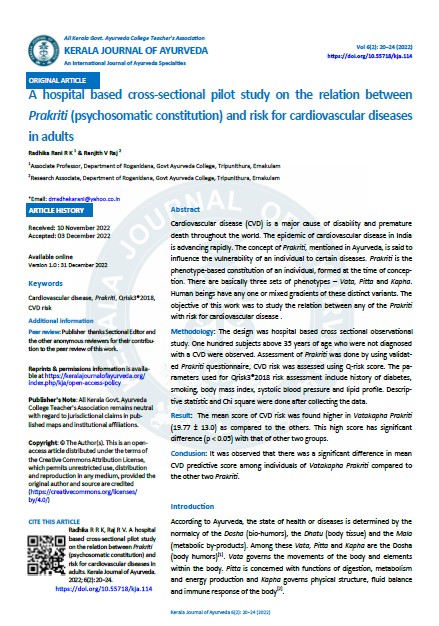A hospital based cross-sectional pilot study on the relation between Prakriti (psychosomatic constitution) and risk for cardiovascular diseases in adults
DOI:
https://doi.org/10.55718/kja.114Keywords:
Cardiovascular disease, Prakriti, Qrisk3®2018, CVD riskAbstract
Cardiovascular disease (CVD) is a major cause of disability and premature death throughout the world. The epidemic of cardiovascular disease in India is advancing rapidly. The concept of Prakriti, mentioned in Ayurveda, is said to influence the vulnerability of an individual to certain diseases. Prakriti is the phenotype-based constitution of an individual, formed at the time of conception. There are basically three sets of phenotypes – Vata, Pitta and Kapha. Human beings have any one or mixed gradients of these distinct variants. The objective of this work was to study the relation between any of the Prakriti with risk for cardiovascular disease. The design was hospital based cross sectional observational study. One hundred subjects above 35 years of age who were not diagnosed with a CVD were observed. Assessment of Prakriti was done by using validated Prakriti questionnaire, CVD risk was assessed using Qrisk3®2018 score. The parameters used for this scoring system include history of diabetes, smoking, body mass index, systolic blood pressure and lipid profile. Descriptive statistic and Chi square were done after collecting the data. It was observed that all the participants were Dwandwaprakriti of which 46% belonged to Pittakapha prakriti. The mean score of CVD risk was found higher in Vatakapha Prakriti (19.77 ± 13.0) as compared to the others. This high score has significant difference (p < 0.05) with that of other two groups. It was concluded that there was a significant difference in mean CVD predictive score among individuals of Vatakapha Prakriti compared to the other two Prakriti.
References
Hankey A. A test of the systems analysis underlying the scientific theory of Ayurveda's Tridosha. J Altern Complement Med 2005 Jun;11[3]: p.385-90.
Dwarakanath C. The Fundamental Principles of Ayurveda. Part III. Reprint edition. Varanasi, India: Krishnadas Academy; 2009. p. 102.
Sharma RK, Bhagvan D, editor. Charaka Samhita of Agnivesha. Vimana Sthana. Ch. 8, Ver. 95. Reprint Edition. Varanasi: Chowkhamba Prakashan; 2007. p. 262.
Priyavrat Sharma, editor. Susrutha Samhita Sarira Sthana. Ch. 4 ver.74. Reprint Edition. Varanasi: Chowkhamba Prakashan; 2010. p.165.
Sharma RK, Bhagvan D, editor. Charaka Samhita of Agnivesha. Vimana Sthana. Ch. 6, Ver.15. Reprint Edition. Varanasi: Chowkhamba Prakashan; Vol I, 2007. p.192
Sharma RK, Bhagvan D, editor. Charaka Samhita of Agnivesha. Sutra Sthana. Ch. 7, Ver. 41. Reprint Edition. Varanasi: Chowkhamba Prakahsan; Vol II, 2007. p.156
WHO World Health Statistics 2018 [Internet]. [cited 2022 Nov 08]. Available from https://www.who.int/india/health-topics/cardiovascular-diseases.
Pappachan MJ. Increasing prevalence of lifestyle diseases: high time for action. Indian J Med Res. 2011 Aug;134[2]: p.143-145.
Qrisk3®2018 risk calculator. Available from https://qrisk.org/three
Sanjeev Rastogi, Francesco: Development of a Prakriti analysis tool AYU J ,2012 April – June 33 (2): p.209-211





